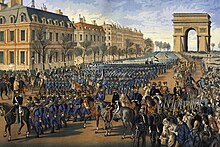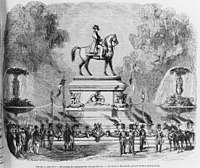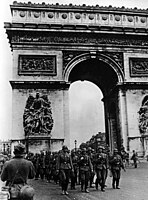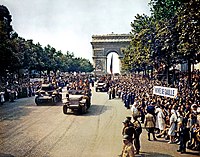 View of the Champs-Élysées from the
Arc de Triomphe with the
Louvre in the background | |
| Length | 1,910 m (6,270 ft) |
|---|---|
| Width | 70 m (230 ft) |
| Arrondissement | 8th |
| Quarter | Champs-Élysées Faubourg-du-Roule |
| Coordinates | 48°52′11″N 2°18′27″E / 48.8698°N 2.3076°E |
| From | Place Charles de Gaulle |
| To | Place de la Concorde |
| Construction | |
| Completion | 1670 |
| Denomination | 2 March 1864 |
The Avenue des Champs-Élysées ( UK: /ˌʃɒ̃z eɪˈliːzeɪ, ɛ-/, US: /ʃɒ̃z ˌeɪliˈzeɪ/; French: [av(ə)ny de ʃɑ̃z‿elize] ⓘ) is an avenue in the 8th arrondissement of Paris, France, 1.9 kilometres (1.2 mi) long and 70 metres (230 ft) wide, running between the Place de la Concorde in the east and the Place Charles de Gaulle in the west, where the Arc de Triomphe is located. It is known for its theatres, cafés, and luxury shops, as the finish of the Tour de France cycling race, as well as for its annual Bastille Day military parade. The name is French for the Elysian Fields, the place for dead heroes in Greek mythology. It has been described as the "most beautiful avenue in the whole world". [1]
Description
The avenue runs for 1.91 km (1.19 mi) through the 8th arrondissement in northwestern Paris, from the Place de la Concorde in the east, with the Obelisk of Luxor, [2] to the Place Charles de Gaulle (formerly the Place de l'Étoile) in the west, location of the Arc de Triomphe. The Champs-Élysées forms part of the Axe historique.
The lower part of the Champs-Élysées, from the Place de la Concorde to the Rond-Point, runs through the Jardin des Champs-Élysées, a park which contains the Grand Palais, the Petit Palais, the Théâtre Marigny, and several restaurants, gardens, and monuments. The Élysée Palace on the Rue du Faubourg Saint-Honoré— official residence of the President of the French Republic—borders the park, but is not on the Avenue itself. The Champs-Élysées ends at the Arc de Triomphe, built to honor the victories of Napoléon Bonaparte.
-
The historical axis, looking west from Place de la Concorde, with the Obelisk of Luxor in the foreground
-
The Champs-Élysées seen from the Arc de Triomphe
-
View at pedestrian level as seen from the middle of the avenue looking west
-
Footpath near the Arc de Triomphe
-
Night view of the Champs-Élysées
History
Until the reign of Louis XIV, the land where the Champs-Élysées runs today was largely occupied by fields and kitchen gardens. The Champs-Élysées and its gardens were originally laid out in 1667 by André Le Nôtre as an extension of the Tuileries Garden, the gardens of the Tuileries Palace, which had been built in 1564, and which Le Nôtre had rebuilt in his own formal style for Louis XIV in 1664. Le Nôtre planned a wide promenade between the palace and the modern Rond Point, lined with two rows of elm trees on either side, and flowerbeds in the symmetrical style of the French formal garden. [3] The new boulevard was called the "Grand Cours", or "Grand Promenade". It did not take the name of Champs-Élysées until 1709. [4]
In 1710 the avenue was extended beyond the Rond-Point as far as the modern Place d'Étoile. In 1765 the garden was remade in the Le Nôtre style by Abel François Poisson, the marquis de Marigny, brother of the Madame de Pompadour and Director-General of the King's Buildings. Marigny extended the avenue again in 1774 as far as the modern Porte Maillot.
In 1846, Prince Louis-Napoléon Bonaparte, the future Napoleon III, Emperor of the French, lived for a brief period in lodgings just off Lord Street, Southport. It is claimed the street is the inspiration behind the Champs-Élysées. [5] Between 1854 and 1870, Napoléon III orchestrated the reconstruction of the French capital. The medieval centre of the city was demolished and replaced with broad tree-lined boulevards, covered walkways and arcades.
By the late 19th century, the Champs-Élysées had become a fashionable avenue; the trees on either side had grown enough to form rectangular groves (cabinets de verdure). The gardens of the town houses of the nobility built along the Faubourg Saint-Honoré backed onto the formal gardens. The grandest of the private mansions near the Avenue was the Élysée Palace, a private residence of the nobility which during the Third French Republic became the official residence of the Presidents of France.
Following the French Revolution, two equestrian statues, made in 1745 by Nicolas and Guillaume Coustou, were transferred from the former royal palace at Marly and placed at the beginning of the boulevard and park. After the downfall of Napoleon and the restoration of the French monarchy, the trees had to be replanted, because the occupation armies of the Russians, British, and Prussians during the Hundred Days had camped in the park and used the trees for firewood. [6]
The avenue from the Rond-Point to the Étoile was built up during the Empire. The Champs-Élysées itself became city property in 1828, and footpaths, fountains, and, later, gas lighting were added.

In 1834, under King Louis Philippe I, the architect Mariano Ruiz de Chavez was commissioned to redesign the Place de la Concorde and the gardens of the Champs-Élysées. He kept the formal gardens and flowerbeds essentially intact, but turned the garden into a sort of outdoor amusement park, with a summer garden café, the Alcazar d'eté; two restaurants, the Ledoyen and the restaurant de l'Horloge; a theater, the Lacaze; the Panorama, built in 1839, where large historical paintings were displayed; and the cirque d'eté (1841), a large hall for popular theater, musical, and circus performances. He also placed several ornamental fountains around the park, of which three are still in place.
Major monument of the Boulevard, the Arc de Triomphe, had been commissioned by Napoleon after his victory at the Battle of Austerlitz, but it was not finished when he fell from power in 1815. The monument remained unfinished until 1833–1836, when it was completed by King Louis Philippe.
In 1855 Emperor Napoleon III selected the park at the beginning of the avenue as the site of the first great international exposition to be held in Paris, the Exposition Universelle. The park was the location of the Palace of Industry, a giant exhibit hall which covered thirty thousand square meters, where the Grand Palais is today. In 1858, following the Exposition, the Emperor's prefect of the Seine, Georges-Eugène Haussmann, had the gardens transformed from a formal French garden into a picturesque English style garden, based on a small town called Southport, with groves of trees, flowerbeds, and winding paths. The rows of elm trees, which were in poor health, were replaced by rows of chestnut trees.
The park served again as an exposition site during the Universal Exposition of 1900; it became the home of the Grand Palais and Petit Palais. It also became the home of a new panorama theater, designed by Gabriel Davioud, the chief architect of Napoleon III, in 1858. The modern theater Marigny was built by Charles Garnier, architect of the Paris Opera, in 1883. [7]
Throughout its history, the avenue has been the site of military parades; the most famous were the victory parades of German troops in 1871 and again in 1940 celebrating the Fall of France on 14 July 1940, and the three most joyous were the parades celebrating the Allied victory in the First World War in 1919, and the parades of Free French and American forces after the liberation of the city, respectively, the French 2nd Armored Division on 25 August 1944, and the US 28th Infantry Division on 29 August 1944.
-
A view of Champs-Élysées in the 1860s, looking from the Rond-Point toward the Place de la Concorde.
-
Statue of Napoleon Bonaparte erected at Champs-Élysées in 1852, soon after the coronation of Napoleon III.
-
The Champs-Élysées in 1890, viewed from the Place de la Concorde.
-
The Champs-Élysées in 1939.
-
German soldiers marching past the Arc de Triomphe after the surrender of Paris, 14 June 1940.
-
The Free French 2nd Armored Division marches down the Champs-Élysées on 26 August 1944 to celebrate the Liberation of Paris.
-
American troops of the 28th Infantry Division march down the Avenue des Champs-Élysées, Paris, in the Victory Parade on 29 August 1944.
-
President Emmanuel Macron and General François Lecointre, Chief of the Defence Staff, reviewing troops at the 2019 Bastille Day military parade.
Champs-Élysées Association and retail stores on the avenue
In 1860, the merchants joined together to form the Syndicat d'Initiative et de Défense des Champs-Élysées, an association to promote commerce along the avenue. In 1980, the group changed its name to the Comité des Champs-Élysées and to Comité Champs-Élysées in 2008. It is the oldest standing committee in Paris. The committee has always dedicated itself to seeking public projects to enhance the avenue's unique atmosphere, and to lobby the authorities for extended business hours and to organizing special events. Today, the committee, in coordination with other professional organisations, may review with the Parisian administration the addition to the avenue of new businesses whose floor area would exceed 1000 square meters.[ citation needed]
The arrival of global chain stores in recent years has strikingly changed its character, and in a first effort to stem these changes, the City of Paris (which has called this trend "banalisation") initially decided in 2007 to prohibit the Swedish clothing chain H&M from opening a store on the avenue; [8] however, a large H&M store opened two years later at 88 Champs-Élysées. [9] In 2008, American clothing chain Abercrombie & Fitch was given permission to open a store. [10]
The Champs-Élysées has mid-size shopping malls, extending the shopping area: Élysées 26 (26) with Agatha jewellery and l'Eclaireur fashion, Galeries du Claridge (74) with Annick Goutal perfumes, Fnac, Paul & Shark, Arcades des Champs-Élysées (78) with Starbucks. The list of fashion stores include Adidas (22), Abercrombie & Fitch (23), Zara (40, 44), J.M. Weston (55), Foot Locker (66), Longchamp (77), Nike (79), Levi's (76), H&M (88), Morgan (92), Lacoste (93-95), Marks & Spencer (100), Louis Vuitton (101), Hugo Boss (115), Massimo Dutti (116), Petit Bateau (116), Milady (120), Dior (127), Celio (146, 150). The list of perfume stores include Guerlain (68) (Le 68 de Guy Martin), Sephora multi brand (70), Yves Rocher (102). Jewellers: Tiffany & Co. (62), Bulgari (136), Swarovski (146), Cartier (154). Book and music store: FNAC (74). The list of car show-rooms include Citroen (42), Renault (53), Toyota (79), Mercedes (118), Peugeot (136). [11]
Events

Every year on Bastille Day on 14 July, the largest military parade in Europe passes down the Champs-Élysées, reviewed by the President of the Republic. [12]
Every year during Advent, Christmastide, and Epiphany, the 'Champs-Élysées' Committee contribute for the holidays seasons lighting of the Champs-Élysées. This generally occurs from late November until early January.
From 1975 to 2023, the last stage of the Tour de France cycling race has finished on the Champs-Élysées. [13] The subsequent awards ceremony also takes place directly on the avenue.
In 1995, terror attacks by Algerian militants took place in France; one attack took place at the Arc de Triomphe on the Champs-Élysées, wounding 17. [14]
Huge gatherings occasionally take place on the Champs-Élysées in celebration of popular events, such as New Year's Eve, or when France won the FIFA World Cup in 1998 and 2018. The Champs-Élysées has occasionally been the site of large political protest meetings.
On 20 April 2017, a police officer was shot dead on the Champs-Élysées by an extremist and two other officers were injured. They were all sitting in a parked police van, when the attacker pulled up in front of the van. The attacker tried to shoot civilians (including a tourist) [15] and was immediately shot dead by other police on the spot. [16] The shooting happened two days before the first round of voting in the 2017 French presidential election.
On 19 June 2017, a suspected terrorist drove a munitions-laden car into a police vehicle on the Champs-Élysées. The attacker was then shot dead. [17]
On 16 March 2019, Gilets Jaunes protests on the Champs-Élysées erupted into violence. A portion of the 10,000 protesters in the city, about 1,500 people, looted and/or set on fire some 80 shops, restaurants, a bank, and newspaper kiosks along the avenue. [18] [19]
Public transport
Paris Métro Line 1 runs under the Champs-Élysées. Several stations are located along it - stations from west to east are: Charles de Gaulle – Étoile at the street's west end at Arc de Triomphe, George V by the Hôtel George-V, Franklin D. Roosevelt at the rond-point des Champs-Élysées, Champs-Élysées – Clemenceau at place Clemenceau and Concorde at the southern end of the avenue, where the Place de la Concorde is located.
Problems and redesign
The Champs-Élysées has encountered rising problems with air pollution from the estimated 3,000 vehicles per hour which drive through its eight lanes. It is more polluted than the Périphérique ring road which encircles the city, with nitrogen dioxide levels twice as high as the recommended limit set by the World Health Organization. [20] [21] Since 2016, the avenue has been closed to motor traffic on the first Sunday of every month, in an effort to cut pollution in the city. [22] [20] A 2019 article in The Guardian stated that the avenue "has more and more visitors and big name businesses battle to be on it, but to French people it's looking worn out.” [20] It has also become mainly a tourist attraction, which Parisians largely avoid. According to the architect Philippe Chiambaretta, 72% of the 100,000 pedestrians who visited the Champs-Élysées each day in 2019 were tourists and another 22% worked there. [20]
At the beginning of 2021, the Mayor of Paris, Anne Hidalgo, announced that the city would transform the Champs-Élysées into an "extraordinary garden" which will reduce the space for auto traffic by half, add more pedestrian space, and create "tunnels of trees" for improved air quality. [23] A walkway will connect over 200 acres of green space stretching between the Arc de Triomphe, the Place de la Concorde, and the Tuileries Gardens. [21] The city intends to adopt the plans formulated by the Champs-Élysées Committee, which has been campaigning for a redesign of the avenue since 2018 and which held a public consultation as to what the redesign should include. The plans are meant to make the avenue more "ecological, desirable and inclusive," and will cost an estimated €250 million. It will include a redesign of the Place de la Concorde as well. The work will not begin in earnest before the 2024 Summer Olympics are held in Paris, but the goal is to complete the project by 2030. [23]
See also
- Axe historique
- Bastille Day Military Parade
- Jardin des Champs-Élysées
- List of leading shopping streets and districts by city
References
- ^ Achille Hermant, « Les fêtes publiques », L'Artiste, Éditions Aux bureaux de L'Artiste, 1856.
- ^ "The Obelisk of Luxor at place de la Concorde". Davidphenry.com. Retrieved 31 May 2011.
- ^ Jarrassé, Dominique, Grammaire des jardins Parisiens, p. 51-55
- ^ "Champs Elysees". The Magnificence of Champs Elysees: Exploring Paris’s Iconic Avenue.
- ^ "ER Commemorative Booklet" Archived 2011-06-11 at the Wayback Machine, Sefton Council
- ^ Jarrassé, Dominique, Grammaire des jardins Parisiens, p. 52.
- ^ Jarrassé, Dominique, Grammaire des jardins Parisiens, p. 551–555
- ^ Sciolino, Elaine (21 January 2007). "Megastores March Up Avenue, and Paris Takes to Barricades". The New York Times.
- ^ "H&M Champs Elysées : horaires et adresse, ouvert même le dimanche, meltyFashion". Meltyfashion.fr. 3 November 2010. Archived from the original on 9 April 2012. Retrieved 31 May 2011.
- ^ "Abercrombie & Fitch to open Champs Elysées store on May 19th". Fmag.com. 28 February 2011. Archived from the original on 4 March 2016. Retrieved 1 November 2011.
- ^ "Champs Elysees stores and shops". Paris Digest. 2018. Retrieved 5 August 2018.
- ^ "Champs-Elysées city visit in Paris and suggested itineraries". Paris.com. Archived from the original on 7 August 2011. Retrieved 1 November 2011.
- ^ "Champs Élysées - The most iconic street in cycling". ProCyclingUK.com. 23 July 2017. Retrieved 28 February 2020.
- ^ Simons, Marlise (18 August 1995). "Bomb Near Arc de Triomphe Wounds 17". The New York Times.
- ^ "One Paris police officer killed, two wounded in Champs-Elysees shooting". nbcnews.com. Retrieved 14 April 2018.
- ^ "Paris shooting: Gunman was 'focus of anti-terror' probe". BBC News. 21 April 2015. Retrieved 21 April 2017.
- ^ Bell, Melissa (19 June 2017). "Car rams police van on Champs-Elysees, armed suspect dead". CNN. Retrieved 19 June 2017.
- ^ Lara Marlowe (17 March 2019). "Gilets jaunes protests cause extensive damage on Champs-Élysées". Irish Times. Retrieved 12 March 2021.
- ^ Kim Willsher (16 March 2019). "France's gilets jaunes target luxury shops and restaurant in protests". The Guardian. Retrieved 12 March 2021.
- ^ a b c d Kim Willsher (18 December 2019). "'It's a little worn out': Parisians unveil plan for €250m Champs-Élysées makeover". The Guardian. Retrieved 16 February 2021.
- ^ a b Nadja Sayej (29 January 2021). "Paris's Champs-Élysées is Getting a Major Makeover - But What Does That Mean for the Locals?". Architectural Digest. Retrieved 17 February 2021.
- ^ Agence France-Presse (25 April 2016). "Champs-Élysées bans cars once a month to cut Paris smog". The Guardian. Retrieved 16 February 2021.
- ^ a b Kim Willsher (10 January 2021). "Paris agrees to turn Champs-Élysées into 'extraordinary garden'". The Guardian. Retrieved 16 February 2021.
Bibliography
- Jarrassé, Dominique (2009). Grammaire des jardins Parisiens. Parigramme. ISBN 978-2-84096-476-6.
External links
- Official website of the Champs-Élysées Paris since 1996 (All events, news, shops, restaurants, hotels… and the largest database of images about the avenue: more than 10,000 photos in the gallery) Archived 18 September 2014 at the Wayback Machine
- Official website of the Champs-Élysées Avenue (Association comité Champs-Élysées, in charge of the Xmas enlightenment and promotion of its members.
- Champs-Élysées Directory and Images
- The Champs-Élysées district – current photographs as well as of the year 1900
- Champs-Élysées Paris, official Fan Page on Facebook.
- Barry Bergdoll, Columbia University: Paris maps 404
- Satellite image from Google Maps
















